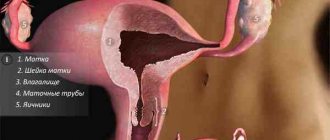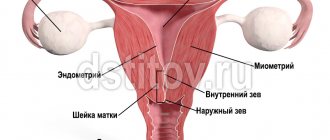Juvenile bleeding is a group of dysfunctional menstrual cycle disorders during puberty that are not associated with organic pathologies. Dysfunctional juvenile bleeding appears during the period of formation of the hormonal function of the ovaries; their causes can appear long before the onset of menstruation, or occur after the first menstruation.
The ovaries as a hormonal gland begin to form during active puberty (puberty). The age norm of puberty has wide acceptable limits, but its physiological boundaries are between the ages of 8 and 16 years. During this age interval, the ovaries “mature,” but the pace of their development often varies individually, so not all girls experience their first menstruation (menarche) at the same age. During puberty, successive structural and functional changes occur not only in the tissues of the ovaries, the most significant of them are also present in the brain - in the centers that regulate ovarian function. The pituitary gland and hypothalamus, together with the ovaries, form the main link of the reproductive system, therefore the maturation of the ovaries and these centers is always symmetrical.
So, how and when is the menstrual cycle formed, and what are its generally accepted normal parameters?
Puberty begins at the age of 8 and ends (in healthy girls) by the age of 16. Upon completion, the ovaries are able to function as a hormonal female gland, and the girl’s external features acquire an “adult” hue. During this time period, growth zones in the tubular bones close, the body actively grows in length, and muscle and fat tissue are distributed in such a way that the girl’s figure becomes “female.”
The processes of puberty occur gradually, which allows the entire puberty to be divided into several important stages:
— Preparatory, prepubertal period. Starts at 8-9 years of age. The girl’s body begins to synthesize estrogens for the first time. They are produced sporadically and chaotically, and their level is too low to maintain full hormonal function of the ovaries.
“Growth surges” of the body begin, the first external signs of gender appear: the contour of the hips is rounded, a “female” pelvis is formed. The mucous membrane lining the genital tract also begins to actively change: it loses its single-layer structure due to the appearance of a layer of intermediate cells.
- The beginning of puberty, or puberty itself. He has owned it for several years. In the first half (10-13 years), the pituitary gland indirectly (through the secretion of FSH and LH) stimulates the onset of hormonal activity of the ovaries. Ovarian hormones, in turn, provoke the development of mammary glands, female-type hair growth on the body and a change in the composition of the microflora in the vaginal mucosa (lactobacteria appear). At the end of this period, intensive body growth is completed.
The culmination of the first phase of puberty is the first menstruation (menarche).
— The final phase of puberty. The first menstruation is not identical to the full hormonal function of the ovaries. Hormones are still synthesized without a clearly established rhythm, and their levels are still not sufficient to ensure ovulation. By the age of 16, when the second phase of puberty ends, the ovaries begin to work in a cyclical rhythm, and the concentration of FSH and LH can stimulate full ovulation. Complete hormonal support for the end of puberty ensures the completion of the development of the female phenotype.
Menarche and full ovulation are important criteria for the correct formation of the ovaries. However, after the start of menstrual function, regular periods occur only in 20% of girls, and only in 25% the first cycles are ovulatory in nature. As a rule, menstrual function normalizes on its own after some time. However, sometimes menstruation during this age period (juvenile) acquires signs of bleeding.
Juvenile bleeding does not develop due to anatomical pathology. At their origins, there is often a violation of the functional connection between the ovaries and the regulatory organs (pituitary-hypothalamus), which is why they are called dysfunctional. Juvenile bleeding is most often diagnosed in the first two years after the start of menstruation.
The clinical picture of juvenile bleeding is very diverse, some of them do not require serious correction, while others lead the girl to the hospital. Uterine bleeding in girls requires a detailed examination, since sometimes they are provoked by non-gynecological causes: diseases of the blood, liver, thyroid gland and others.
To eliminate uterine bleeding, it is necessary to establish its cause, so stopping juvenile bleeding is only one of the stages of therapy. The list of therapeutic measures depends on the characteristics of each specific case and may involve both simple hemostatic therapy and serious hormonal treatment.
In most young patients, dysfunctional bleeding has a favorable prognosis and disappears after adolescence.
Causes
JMC have a polyetiological origin and appear as a result of many factors, both external and internal. The most common cause of juvenile bleeding in girls is disruption of the reproductive system during the formation of the menstrual cycle. As a result of this disorder, the concentration of estrogen and progesterone changes, which causes uterine bleeding. Factors that provoke the appearance of juvenile uterine bleeding:
- blood diseases (including von Willebrand-Diana disease);
- heredity;
- excessive physical activity;
- strong emotional experiences and regular stress (problems at school, quarrels with parents or peers, etc.);
- vitamin imbalance in the body;
- chronic and acute infectious pathologies;
- disruption of the endocrine system;
- liver dysfunction.
JMC also depend on the physiology of a teenage girl. In the medical field, there are three types of disorders:
- hyperestrogenic: most often observed in children with psychological immaturity and excessive physiological and sexual development;
- normoestrogenic: occurs in young girls and adolescents with normal development and an underdeveloped uterus;
- hypoestrogenic: this type of disorder is encountered by young girls with a well-developed psyche, whose secondary sexual characteristics are poorly developed.
Provoking factors
Among the provoking factors for the occurrence of juvenile uterine bleeding in adolescents are:
- Infectious diseases of acute and chronic nature.
- Imbalance of vitamins in the body.
- Stress and strong feelings.
- Serious physical activity inappropriate for age.
- Genetic predisposition.
- Pathologies of the endocrine glands.
- Blood diseases.
- Liver pathologies.
Against the background of JMC, girls can develop pathologies such as corpus luteum and follicular cysts. Uterine bleeding in young patients also depends on the physiological development of the child, so in medicine there are three types of abnormalities:
- Hypoestrogenic. Most often, this type occurs in girls with developed intelligence and weakly expressed secondary sexual characteristics.
- Normoestrogenic. It is typical for girls with normal physical development and an underdeveloped uterus.
- Hyperestrogenic. It is observed in girls with accelerated physical development and psychological immaturity.
Classification and forms
According to the degree of blood loss, there are three types of juvenile uterine bleeding in adolescents:
- metrorrhagia - develops against the background of the absence of scanty menstrual flow and is not cyclical;
- menorrhagia - with this type of bleeding, the menstrual cycle is not disrupted, but blood loss lasts longer than 7 days and exceeds 80 ml/day;
- polymenorrhea - the menstrual cycle persists, but lasts no longer than 3 weeks.
Important information: Why does scarlet blood flow from the anus (butt) during bowel movements in women (men) and what adults should do to treat heavy bleeding
Experts have found that JMC is most often encountered by children whose mothers suffered from infectious diseases during pregnancy.
Types of DMK
Dysfunctional bleeding from the uterus is divided into two types:
- Ovulatory. Appears in women of reproductive age. Bleeding begins approximately in the middle of the cycle and is a consequence of a significant decrease in estrogen in the blood.
- Anovulatory. Occurs when ovulation is completely absent. The root cause is a malfunction of the ovaries, pituitary gland and hypothalamus, leading to changes in the secretion of hormones.
Based on the nature of modifications, DMKs are divided into 4 subtypes:
- Menorrhagia. Heavy discharge accompanying menstruation or long periods.
- Metrorrhagia. Bloody discharge is irregular and most often occurs between cycles.
- Menometrorrhagia. Irregular and prolonged bleeding.
- Polymenorrhea. The interval between the days of menstruation is less than 21 days.
It is also customary to distinguish DMK by the woman’s age.
Juvenile
Typical for girls from 11 to 18 years old. Failure of hormone secretion can be a consequence of psychological trauma, vitamin deficiency, physical and mental fatigue, and poor environmental conditions in the place of residence. Dysfunction is often detected after chicken pox, measles, whooping cough, and rubella.
Reproductive period
Dysfunctional uterine bleeding of reproductive age is possible before menopause. Associated with stress and infections. DMC is possible after abortion or surgery. In women with bleeding, it is necessary to exclude inflammatory processes of the reproductive organs and neoplasms.
Menopause
DUB of menopause can occur in patients aged 45 to 55 years. At this time, the function of the ovaries fades away, the pituitary gland no longer produces hormones in full. This leads to the fact that ovulation occurs rarely, the cycle is disrupted and metrorrhagia develops.
Clinical manifestations
JMCs occur between the first menstruation and the next two years. Signs of violation:
- high or low blood pressure;
- systematic dizziness;
- constant feeling of thirst;
- pale skin;
- increased fatigue and feeling tired;
- sudden mood swings;
- bleeding is observed between menstruation;
- the cycle lasts less than 3 weeks;
- discharge lasts longer than 15 days;
- heavy blood loss continues for more than a week.
If you suspect JMC, you should pay attention to the duration, volume and cyclicity of bleeding. If you feel unwell or have any abnormalities, you should seek help from a specialist.
Emergency care for juvenile bleeding
Every mother should know how to help her daughter if she has juvenile bleeding. If there is heavy discharge, you need to call an ambulance and take the following actions:
- The child must be placed on the bed.
- Place an ice pack wrapped in a towel on your lower abdomen for 15 minutes at 5-minute intervals.
- Give plenty of sweet water or tea.
- You can give a vitamin C tablet.
- Wait for an ambulance and hospitalize the child.
It is worth noting that contacting a specialist is mandatory even if the bleeding was stopped on your own. You need to understand that as a result of regular blood loss, the child is deprived of a large amount of hemoglobin, and this, in turn, is dangerous due to the development of serious pathologies.
Diagnostics
Sometimes it is extremely difficult to distinguish menstrual flow from JMC, and only a doctor can accurately diagnose the problem. Basic diagnostic methods:
- interviewing the patient to identify the presence of congenital or chronic pathologies;
- study of anamnesis;
- visual examination, which can help identify deviations in puberty (the size of the mammary glands, the presence of vegetation on the pubis and in the axillary recesses);
- blood test for hormones to determine the level of estradiol, prolactin, progesterone, FSH and LH;
- Ultrasound.
After stopping the bleeding, you need to additionally undergo:
- echography of the adrenal glands and thyroid gland;
- secondary ultrasound examination of the pelvic organs;
- electroencephalogram;
- X-ray of the skull;
- CT scan of the brain;
- echoencephalogram.
To confirm/exclude the diagnosis, you should consult an oncologist, neurologist, endocrinologist and hematologist.
Are there effective methods of prevention?
It's no secret that sometimes it is much easier to prevent the development of a particular disease than to then undergo treatment and deal with complications. Modern medicine recommends preventive maintenance therapy to prevent new bleeding.
From the fifth to the fifteenth day of the menstrual cycle, patients are prescribed vitamin E, folic and glutamic acid, as well as a vitamin B solution intravenously. From days 16 to 26 of the cycle, the treatment regimen looks different - girls take ascorbic acid and B vitamins. Such treatment is carried out for three months after the bleeding has stopped and, according to reviews, gives really good results.
If the bleeding was stopped with the help of hormonal drugs, then the patient is advised to take small doses of progestins, in particular Logest, Novineta, Silesta and some other drugs. Girls who have had curettage followed by hormonal cessation of bleeding are prescribed estrogen-progestin medications.
Treatment
If there is heavy bleeding, you should call an ambulance. Additionally, the following measures need to be taken:
- the teenager needs to take a horizontal position;
- Place an ice pack wrapped in a soft towel on the lower abdomen for 10-15 minutes;
- the child needs to be provided with plenty of fluids in the form of sweetened tea or water;
- It is advisable to give the girl 1 tablet or capsule of vitamin C.
Important information: Why is there traces of blood in the urine of a child (boy and girl) after urination?
You should consult a doctor even if the bleeding stops on its own. Timely diagnosis and treatment of pathology will help avoid negative consequences.
For juvenile bleeding in teenage girls, treatment is carried out in two stages.
To begin with, the doctor sets himself the task of stopping the bleeding. If the pathology is severe, then classical means to stop bleeding may be ineffective. In such situations, hormonal therapy is prescribed by taking gestagens and estrogens.
If the bleeding can be stopped, then medications are prescribed to stabilize the menstrual cycle. In this case, drugs are selected depending on the causes of the disorder and the characteristics of the patient’s body.
In addition, female patients may be prescribed vitamin complexes, physiotherapeutic procedures and a special schedule of physical activity. At this stage, the doctor also pays attention to the psychological state of the patient. Sometimes repeated JMC are observed after stress.
If the bleeding poses a threat to life, then in this case, surgical intervention is prescribed, in which the uterine cavity is curetted. After this, a drug treatment regimen is selected.
The average duration of therapy is 12 months. During this period, the menstrual cycle is established, and irregularities no longer occur.
Prevention
The state of the reproductive and reproductive systems of girls is formed at an early age. After the birth of a child, parents need to not only constantly monitor his hygiene, but also teach him a healthy lifestyle and daily routine. A balanced diet, rich in useful microelements and vitamins, regular walks outside and moderate physical activity - all this will allow the child to develop correctly and prevent many gynecological pathologies.
In addition, to prevent juvenile uterine bleeding in girls, viral and infectious diseases should be promptly treated and regularly visited by a gynecologist.
A mother should definitely inform her daughter about the importance of menstruation. It is also advisable for her to monitor this process until the end of puberty.
Your child should be seen for the first time at the gynecologist during their first period.
Thereafter, a gynecological consultation should be sought every six months until adulthood.
The baby's body weight also affects the menstrual cycle. It is necessary to ensure that the child is not overweight or underweight. If necessary, you can additionally consult with a nutritionist on this issue. The specialist will select a nutrition plan for the teenager, help get rid of weight problems and prevent the recurrence of juvenile bleeding in the future.
In addition, mothers should discuss issues with their daughters that explain the dangers and consequences of early sexual intercourse.
Puberty is individual for each child, so you should not self-medicate and try to solve the problem of JMC on your own. It is better to contact a medical specialist who will identify the deviation and prescribe adequate therapy.
Bleeding after installing the IUD Blood from the anus during bowel movements in women during pregnancy How to treat the appearance of blood clots in the stool of an adult and why women (men) may have bloody stools without pain How to stop bleeding from the lips and what to do when they bleed (crack) ) Add a comment Cancel reply
Name *
Email *
A comment
Save my name, email, and website in this browser for the next time I comment.
textarea>
How to distinguish (recognize) heavy periods from uterine bleeding during pregnancy and after childbirth
Symptoms and treatment of thrombosis of the internal jugular vein in the neck
Why does it bleed heavily during early pregnancy without pain and can the fetus survive after bleeding with blood clots?
Instructions for use of ointment (cream) Express Bruise
How to treat cerebral hypoxia in newborns and why oxygen starvation occurs in infants
How to cure varicocele in men with folk remedies (without surgery) at home
What do elevated platelets mean in an adult (causes and consequences)
How to relieve an attack of VSD and its symptoms
How varicose veins of the lower extremities are treated with laser and what is the process of surgery to remove varicose veins on the legs
Complications and consequences
JMC in girls can cause the development of anemia and associated complications. In severe cases, anemia affects many systems and internal organs, which poses a threat not only to health. but also for the life of a teenage girl.
Untimely and improper exfoliation of endometrial tissue can lead to inflammation of the uterus, which can lead to the development of tumors, endometriosis and cysts, which can cause infertility.
Therefore, in case of any deviations, you should consult a doctor.









